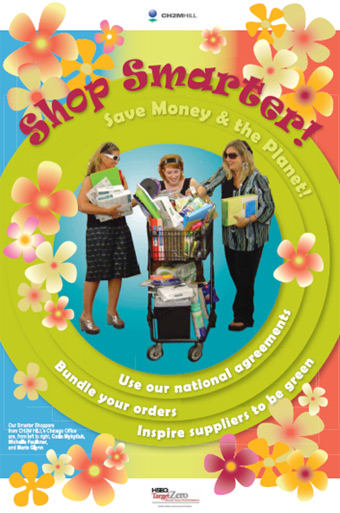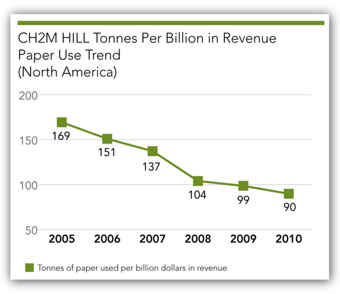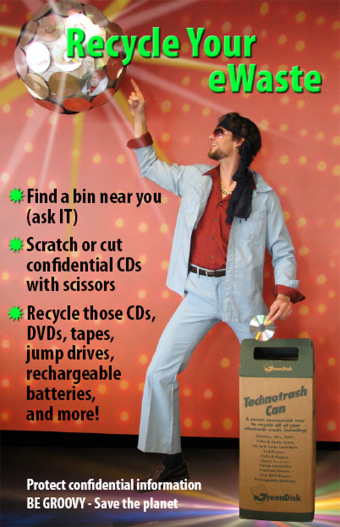CH2M Hill Embracing Environmental Stewardship
If a person walked into an office, would he/she know right away if the company is “sustainable,” or “walking the talk,” or practicing any other green buzzword of the moment? It’s easy to tell if a company has a culture of safety. Cords are firmly ensconced in no-trip guards, fire extinguishers are available, escape routes are posted and exit signs are lit. However, indications of an environmental stewardship culture tend to be more subtle. If employees offer clients coffee in disposable cups, odds are they won’t come away with a green impression. Hand them coffee in ceramic mugs and their perception shifts.
A coffee cup seems trivial until one thinks about what it takes to make that cup of coffee happen. First, a company needs to have a dishwasher that is Energy Star rated and water-efficient. It needs a communication program to encourage employees to put items in the dishwasher themselves so it doesn’t overburden certain staff members. Top leaders have to be seen putting their dishes in the dishwasher. To get the cost-saving, environmental and goodwill benefits of durable dishes instead of disposables, a cultural change needs to occur – one that creates an environment that values getting that ceramic mug into visitors’ hands.
A culture of environmental stewardship needs to be nurtured as an expression of an organization’s core business purpose. To make day-to-day business practices such as recycling or sustainable purchasing meaningful to employees and transparent to customers, efforts need to focus on what the business can actually manage and on what environmental gains can be achieved. Efforts should not focus on what outside stakeholders imagine the business should accomplish.
Align Strategy with Business Purpose
A culture of sustainability can’t be turned on with a switch. It can grow and evolve like a garden, but needs regular tending to establish deep roots. At CH2M Hill, the company history is built around clean water. The business started with clean water projects, and it continues to provide clean water in many communities across the country. As part of an internal environmental program, CH2M Hill doesn’t have bottled water in vending machines at its corporate headquarters, nor does it serve bottled water at meetings in its offices. The additional footprint needed to package and to transport water just doesn’t mesh with company values. The organization is fortunate to have safe and healthy municipal water systems in place that don’t require use of additional resources.
Similarly, every business can begin by asking two questions: What impact does this business have on the environment? What impact does the environment have on this business?

© iStockphoto.com/Mikbis
If a business relies heavily on shipping goods, for example, carbon emissions from fuel have direct effects on climate change and sustainability. Conversely, resource scarcity could cause the price of fuel to climb to the point that the business becomes unprofitable. In this case, fuel would become a central focus of any environmental stewardship or sustainable strategy.
It is rarely this straightforward in a complex political climate with conflicting employee and customer perspectives. The art of sustainability lies in integrating opposites and making the case that makes sense. If a city chooses to preserve open space and limit development near a river listed as compromised under the Clean Water Act, at first glance this sounds like a purely environmental motive driven by environmental regulations. This message and approach would appeal to one group of stakeholders. If the city is doing this to avoid building a costly stormwater treatment system by allowing natural systems to do their job, thereby reducing government spending, that approach appeals to a different group. Goals and values of both groups are important for community support and project success. Gaining the perspective to build inclusive sustainability programs that embrace multiple values in an organization can be difficult. It may be helpful to invite advocates who are further along the pathway to help guide staff through a logical process in developing a framework for addressing stewardship.
With any new management approach, it’s critical to create a program that people want to participate in, regardless of political inclination. The easiest way to do this is to align with and build upon existing company culture. Find what really gets employees excited and start there.
Focus on Ability to Manage
In designing an environmental program, citing examples may not always be fruitful. Statistics abound about how much a particular business recycles or how much energy or water is used. If the business is located in a leased space with no sub-metering of power, water or other utilities, these traditional metrics become all but impossible. A business that doesn’t take out its own trash wouldn’t know what percentage of the waste stream is recycled. In these situations, instead of measuring what goes out, it pays to measure what comes in.

© CH2M Hill
Procurement is an excellent focus for any business, particularly for businesses that don’t manage their own facilities. Partnering with vendors that have environmental programs in place enables both businesses to learn from each other and to push each other in new directions. Vendors can assist with product research and report on how often sustainable items are purchased. This provides a window into choices that employees are making about recycled-content products or those produced by small businesses or minority-owned businesses. Benchmarking these purchases creates opportunity to educate employees about the footprint of materials they touch every day.
Businesses may find that opportunities for improvement exist beyond traditional metrics or procurement. Mining the wealth of information employees hold will uncover these hidden gems. Gather a group of employees from across the business spectrum and ask them to list the things they do for their jobs. Rank these by environmental impact, level of control or influence and other factors important to the core business, such as customer and stakeholder perception. With this sorting process, a few initiatives will rise to the top to be addressed.
Build a Program: Paper Use and Recycling Case Study
Despite proliferation of electronic readers and smartphones, most businesses still use a lot of paper. For a service-based business, paper use generally represents the largest materials use footprint, in addition to computers and electronics. The international, U.N.-endorsed Global Reporting Initiative (GRI) standards call on businesses to disclose materials used by weight or volume and the percentage of materials used that are recycled input materials.
Given sustainability branding opportunities and GRI standard, the entry point for addressing paper use is to buy recycled. Spending precious additional dollars on recycled paper can be difficult, but if one works for the Federal government, it’s a business imperative required by Executive Order 13101. This is a case where more is not always better. An individual paper fiber can only be re-used five times before it becomes too short to bind together into paper. The renewable resource of responsibly managed forests will always be needed to keep more fresh fiber coming into the system. Therefore, the 100 percent recycled paper with high price tag may not be as sustainable in the long term as the 30 or 50 percent recycled content paper with a more modest price point.

© CH2M Hill
The next step is to address business costs and environmental footprint in a more robust way by reducing paper use overall. CH2M Hill began tracking paper use in 2003 and observed that paper use increased with revenue and staff growth every year. In 2005, with implementation of the Environmental Management System (EMS) and more robust electronic delivery tools for clients, the company began to see that trend reverse slightly. Thrilled with the new direction, CH2M Hill began to investigate ways to take a leap forward.
In 2007, the firm implemented a one-two punch: robust communication combined with technology tools. With catchy, fun posters using employees as models, along with intranet news stories, facts and figures, CH2M Hill clearly communicated the need for reducing paper usage. It also posted guidelines in reprographics centers that encouraged people to use less paper and only request copies they need. On the technology front, the company made duplex printing standard on all print and copy devices. Instead of choosing to print double-sided, staff now had to make a choice to print single-sided. In functional areas that require additional security (for example, contracts and human resources), staff had traditionally used banner pages to provide a cover sheet over sensitive documents. CH2M Hill eliminated banner pages and instead switched to print-on-demand so the user walks to the printer and presses a release button for individual, secure jobs.
Between 2006 and 2008, company per-person paper use dropped by six reams, representing a 21 percent per-person reduction. When comparing paper to revenue, paper use dropped by 33 metric tons per billion in revenue in 2007, thus demonstrating that employees did more work with less paper. They currently use about 90 metric tons of paper per billion dollars in revenue compared to nearly 170 metric tons per billion dollars when EMS began in 2005.
CH2M Hill continues to use technology to help drive change in printing habits. In 2009, it implemented print-on-demand for all color printing devices and found it eliminated the stack of unclaimed printouts that tend to accumulate by printers. The firm used that experience to expand this program to all print devices in 2010. Gradually implementing these changes increases acceptance, as people have time to become accustomed to new technology. The key with each of these changes was to communicate the change clearly with a variety of methods. For the print-on-demand initiative, CH2M Hill used e-mails from technology support staff, as well as “point of sale” pieces on individual printers with facts about what these measures save in dollars and resources. Since the company pays per page for printer maintenance, if it printed half of what it did last year, the firm would save $780,000 in maintenance fees alone. Facts like these create a win for business and environment.
Throughout, it’s important for communication pieces themselves to honor environmental commitment and deliver business value. For example, the “point of sale” piece used one sheet of letter-sized paper per printing device for a 16-week campaign. The paper was printed double-sided as four postcards, which were then cut apart. Each postcard was displayed for two weeks: one week on the front image and one week on the information-packed reverse. The 2007 main communication campaign involved employees in all posters and won innovation awards from the League of American Communications Professionals and Business Communications Report.

© CH2M Hill
The ultimate step involves looking beyond material itself and considering broader impacts beyond office walls. Media attention on recycling has focused on electronic waste, but there’s a story behind paper recycling as well. More than one-half of paper collected for recycling in the U.S. is collected in comingled bins and shipped overseas for sorting and recycling, thus depriving U.S. paper mills of valuable raw material – and jobs. Boise, Inc., began working with OfficeMax, their largest paper customer, to identify customers who purchase large amounts of recycled papers and are focused on sustainability and environment. Working collaboratively, the Boise team helped customers set up internal recycling programs and found third-party recyclers to pick up, sort and deliver paper directly to their mills, where it is de-inked and converted into recycled-content papers, which are, in turn, sold back to the customer.
CH2M Hill was an early adopter of the closed loop program with Boise. The company sorts high-grade white paper at the source in its corporate offices in Denver for recycling, and is in the process of identifying other large offices where it could set up similar programs. Partnering with Boise in closed-loop recycling allows the firm to create positive change globally by reducing transportation impacts surrounding recycled papers and locally by supporting communities that depend on pulp mills for economic health. Looking at its primary materials use holistically has enabled CH2M Hill to improve its footprint far beyond simply purchasing recycled paper, and has offered a whole new level of engagement opportunities for employees.
Be Authentic to Avoid Greenwashing
Greenwashing is a significant problem, as explained in the 2010 Greenwashing Report by TerraChoice and Underwriters Laboratory. It is the appropriation of environmental virtue by promoting environmental initiatives or images that are misleading or conceal other, hidden impacts to the environment. The report states, “Applying tests based on the FTC Green Guides, the Canadian Competition Bureau Guidelines for Environmental Claims, ISO 14021 and our own understanding of global best practice
– we find that more than 95 percent of ‘greener’ products commit one or more of seven Sins of Greenwashing.” Authors also noted that “greenwashing declines with experience” and legitimate marketing claims are more than five times greater in mature companies and industries with a better understanding of sustainability in their sector than in those just beginning to explore the green marketplace.
The 2010 Greenwashing Report illustrates the value of taking a stepwise approach to aligning sustainability with company values. Tacking on green initiatives as an afterthought, or solely as a product offering, means staff may not be fully engaged and that becomes apparent to customers. Embedding sustainability within the organization first and growing that as part of the culture leads naturally to authenticity.
Weave Sustainability into the Business Fabric
What sustainability means for an individual business is going to change depending on what that business creates and produces. Top ten lists of the most ecological business practices can point the way, but, ultimately, the art of embracing environmental stewardship is in guiding an ongoing conversation with management, staff and stakeholders. Creativity, openness to change and awareness of new developments in tools or technology that could improve existing processes or reduce current impacts are essential.
Most of all, a business should remain true to its core purpose in pursuing a sustainable future. Create a vision for the business that employees can get excited about. Deliver business value as often as possible, but be alert for opportunities that may not contribute directly to the bottom line but that make significant environmental or social gains that could be financed by other cost reductions. Be dynamic, and be a force for beneficial change.

© CH2M Hill





























